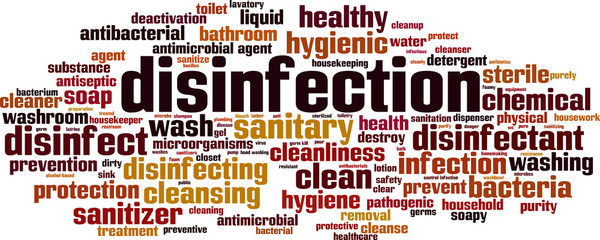

Adoption of Hospital style Infection Control protocols for the Disinfection of Commercial Buildings
– M.T. Boyer
As public spaces in use 24/7, hospitals face the daily challenge of infection control. A stream of people, some contaminated with infectious disease, constantly in motion, in an environment where cleanliness and minimizing infection risk is paramount. While hospitals use a variety of tools for their overall disinfection effort, the foundation upon which all infection control is built, is the Terminal Disinfection.
The Terminal Disinfection is the highest level of disinfection protocols a hospital will use to disinfect infectious disease patient rooms and Operating Rooms at the end of the surgical day. When a space is “terminally” disinfected, a Hospital Operator has utmost confidence the space is fully disinfected and safe. But is there a Terminal Disinfection protocol and guidance available for buildings to start each day freshly disinfected?
The answer to that question could come from the medical industry.
First, the hospital industry’s experience managing infection control can provide guidance and direction for the disinfection of commercial, educational, and institutional buildings, providing assurance to building occupants (i.e. staff and students) as well as parents, organizations, communities, and government leaders.
Secondly, the combination of two known and proven technologies may provide a Terminal Disinfection solution. The combination of advanced HVAC technology and the Sandia National Laboratories, New Mexico disinfection technology that is sold by SpectraShield Technologies as DF-500.
The US Military’s top disinfection technology, DF-200 is biodegradable, certified green, low in toxicity and corrosion but provides maximum kill as a broad-spectrum disinfectant, including coronavirus. But in addition to strong disinfection abilities, DF-200 provides strong mold, mildew, and odor control.
Strategically directed through Air Handling Systems as a fine fog overnight when workers are home, this combination of technologies can provide a potential Terminal Disinfection for commercial structures whether a school, office, or commercial building.
With a known “reset” available for building operators to establish a freshly disinfected space, other infection control measures can be taken to ensure safe operation through the rest of the business day.
(i.e. see ASHRAE, Illumination Society, etc.)
In 2009, a Sandia National Laboratories Study – Knockdown and Neutralization of Clouds of Toxic Chemical and Biological Materials (1) by Mark D. Tucker and Rita G. Betty concluded:
One mechanism for dispersal of these types of materials would be to create an aerosol or vapor
cloud that would drift toward the intended target area in either an indoor or outdoor setting. A
potential method has been developed and tested at Sandia National Laboratories for
neutralization and mitigation of clouds of highly toxic materials. By creating charged sprays of a
Sandia-developed decontamination chemistry (i.e., Sandia DF-200) and introducing it into the
cloud of toxic material, the material can be rapidly and effectively neutralized and knocked to the
ground. This approach has been demonstrated for knockdown and neutralization of biological
pathogens, liquid aerosols of chemical materials, and vapors.
While this study was focused on potential responses to a building contaminated with a chemical or biological weapon, the concept of fogging various spaces to achieve disinfection was confirmed to be effective when using the Sandia Disinfection formula.
Two additional Sandia studies released in 2015 and 2016 also support the concept of utilizing advanced HVAC systems for complex space disinfection.
The 2015 study titled – “Aerosol Delivery of Liquid Decontaminants: A Novel Approach for Decontamination of Complex Interior Spaces”(2), and a 2016 study titled – “Spray knockdown system for rapid containment and neutralization of airborne CBW agents”(3) both analyzed the Sandia Disinfection formula and concluded that, as an aerosolized spray, the Sandia formula is effective against chemical and biological agents.
National Laboratories like Sandia and their sister facility at Lawrence Livermore in California focus on issues of national security and worst-case scenarios.
If aerosolized Sandia disinfectant can combat worst case scenarios, then delivering aerosolized disinfectant via existing advanced HVAC air handling systems should provide a genuine Terminal Disinfection solution for commercial spaces. This automated and integrated solution, with current building automation and analytic strategies, could be a major operating cost reduction factor combating a Coronavirus pandemic or other infectious disease outbreak by utilizing existing HVAC infrastructure to create a low-cost disinfection protocol.
- Knockdown and Neutralization of Clouds of Toxic Chemical and Biological Materials by Mark D. Tucker and Rita G. Betty – SAND2009-1125C
- Aerosol Delivery of Liquid Decontaminants: A Novel Approach for Decontamination of Complex Interior Spaces – Sandia National Laboratories, Albuquerque, NM USA – Mark D. Tucker, Ph.D., Andres Sanchez, Joshua Hubbard, Ph.D., Matthew Tezak, Matthew Hankins, Ph.D., Scott Davison, Ph.D., Steven Storch, Brandon Servantes – SAND2015-3271C
Spray Knockdown System for Rapid Containment and Neutralization of Airborne CBW Agents -Sanida National Laboratories, Albuquerque, NM USA – Mark D. Tucker, Andres L. Sanchez, Charles A. Brusseau, Matthew S. Tezak, Steven M. Storch, Gabriel A. Lucero, Patrick D. Burton, and Jasper O.E. Hardesty – SAND2016-11052C